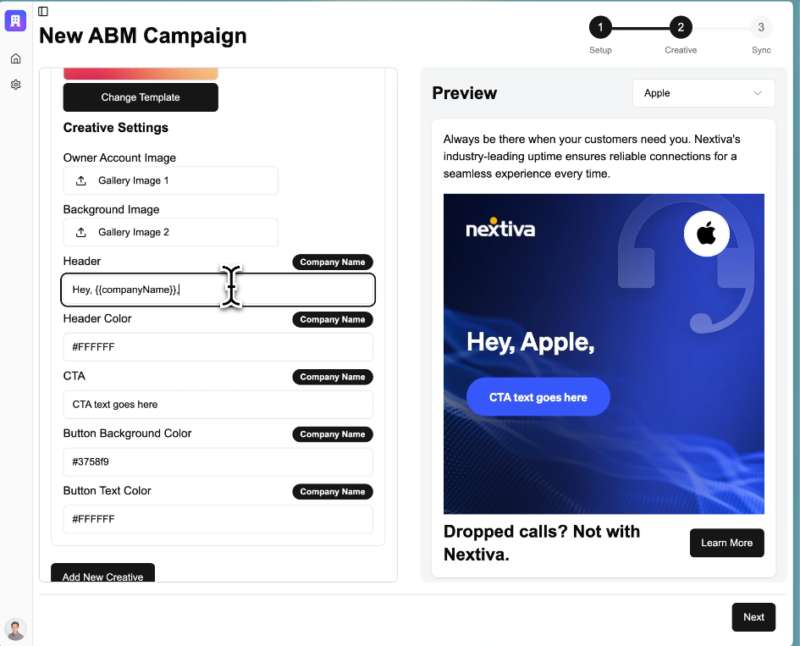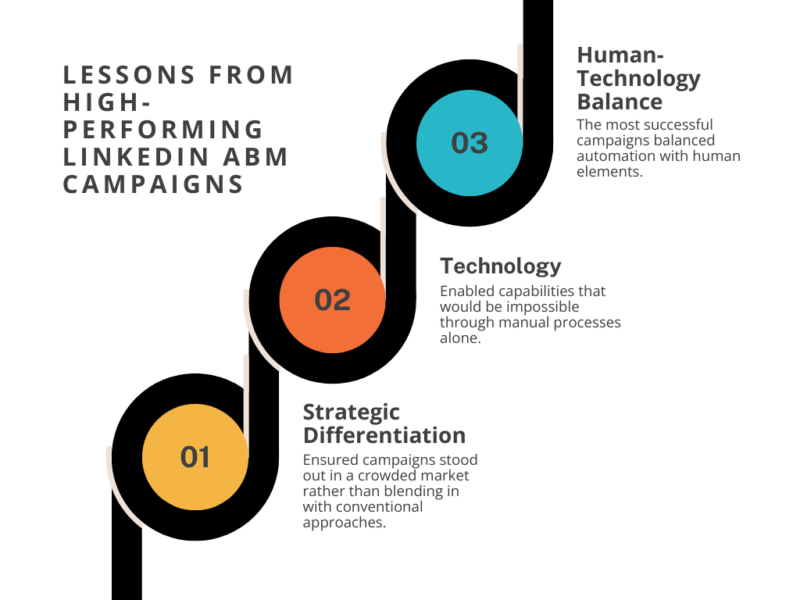Case Studies in Action: Real-World LinkedIn ABM Campaigns that Outperformed Expectations
Account-based marketing (ABM) is a game-changing strategy for businesses targeting high-value accounts. However, companies may encounter problems, such as choosing the best platform for ABM.
This is where LinkedIn comes in. LinkedIn offers many tools and features to execute a successful ABM campaign. Businesses can also integrate different tools, like Karrot.ai, to access account data and personalize all marketing efforts in one place.
Has LinkedIn ABM been successful for other brands? These case studies represent more than just marketing success stories—they showcase how innovative approaches, strategic thinking, and effective execution can transform LinkedIn ABM from a standard marketing tactic into a powerful engine for business growth.
Key Highlights
- Exceptional LinkedIn ABM campaigns have delivered ROI improvements of 300-500% compared to traditional marketing approaches.
- 97% of marketers report that ABM delivers a higher return on investment than other marketing strategies.
- Multi-dimensional personalization was a common factor across all high-performing campaigns.
- Cross-functional collaboration between marketing, sales, and other departments drove superior results.
- Data-driven optimization enabled continuous performance improvement over time.
- AI-powered tools like Karrot.ai played a critical role in the most successful campaigns.
- Measurement sophistication connected campaign activities to revenue outcomes.
- Innovative approaches that broke conventional patterns generated exceptional results.
TABLE OF CONTENTS:
The Anatomy of Exceptional LinkedIn ABM Campaigns
Account-based marketing has transformed B2B marketing, with 70% of marketers now having an active ABM campaign.
ABM strategies are versatile. They combine many inbound marketing tactics and use hyper-personalized targeting to generate revenue from high-value accounts. This is why LinkedIn has emerged as the premier platform for ABM execution; its professional focus and robust targeting capabilities are cost-effective and improve many ABM metrics, such as engagement and click-through rates.
However, not all LinkedIn ABM campaigns deliver equal results. The most exceptional campaigns that dramatically outperform expectations share specific characteristics distinguishing them from average efforts.
Common Success Factors
Across high-performing campaigns, several patterns emerge:
- Strategic account selection: Sophisticated targeting beyond basic firmographics.
- Deep personalization: Account-specific relevance beyond surface-level customization.
- Multi-channel coordination: LinkedIn as the centerpiece of integrated campaigns.
- Sales-marketing alignment: Seamless coordination between teams.
- Continuous optimization: Data-driven refinement throughout campaign lifecycle.
- Technology leverage: Effective use of advanced tools and platforms.
- Creative excellence: Compelling messaging and visuals that capture attention.
- Measurement sophistication: Attribution that connects activities to outcomes.
These factors create a foundation for exceptional performance rather than merely adequate results.
Case Study 1: Enterprise Software Company Transforms Pipeline Generation
Company Background
A leading enterprise software company faced significant challenges with its traditional marketing approach:
- High customer acquisition costs: $18,500 average cost per qualified opportunity.
- Long sales cycles: 9-12 months from initial engagement to close.
- Low target account penetration: Only reaching 22% of identified accounts.
- Fragmented customer experience: Disconnected touchpoints across channels.
- Limited personalization: Generic messaging across diverse account segments.
These challenges limited growth and created inefficiencies in their marketing and sales processes.
The LinkedIn ABM Strategy
The company implemented a comprehensive LinkedIn ABM strategy:
- AI-powered account selection: Using predictive modeling to identify highest-potential targets.
- Role-based personalization: Tailored content for five key stakeholder groups.
- Industry-specific messaging: Customized value propositions for eight vertical markets.
- Sales-marketing coordination: Synchronized outreach across both teams.
- Multi-channel integration: LinkedIn as the hub of a coordinated campaign.

The implementation leveraged Karrot.ai to enable personalization at scale across hundreds of target accounts, creating truly customized experiences without proportional increases in resources.
Campaign Execution
The campaign included several innovative elements:
- Dynamic video personalization: Account-specific video messages for top prospects.
- Interactive assessment tools: Custom diagnostics embedded in LinkedIn content.
- Virtual executive roundtables: Exclusive LinkedIn Live events for target accounts.
- Personalized case studies: Industry and challenge-specific success stories.
- Sales enablement content: Materials designed for sales team collaboration.
This multi-faceted approach ensured target accounts encountered relevant content regardless of how they engaged with the campaign.
Results That Exceeded Expectations
The campaign delivered exceptional results:
| Metric | Before ABM | After ABM | Improvement |
|---|---|---|---|
| Target Account Engagement | 22% | 78% | +255% |
| MQL-to-Opportunity Conversion | 12% | 38% | +217% |
| Average Deal Size | $425,000 | $680,000 | +60% |
| Sales Cycle Length | 9-12 months | 5-7 months | -42% |
| Cost Per Qualified Opportunity | $18,500 | $6,200 | -66% |
| Pipeline Generated | $28.5M | $112.7M | +295% |
These metrics prove that sales and marketing collaboration makes the most significant difference when targeting accounts on LinkedIn.
Key Success Factors
Several elements contributed to the campaign’s exceptional performance:
- Data-driven account selection focused resources on the highest-potential opportunities.
- Deep personalization created genuine relevance for target accounts.
- Sales-marketing alignment ensured consistent experiences across touchpoints.
- Continuous optimization based on performance data improved results over time.
- Technology leverage through Karrot.ai enabled scale without sacrificing quality.
These factors combined to create a campaign that not only met expectations but fundamentally transformed the company’s growth trajectory.
Case Study 2: Manufacturing Company Revolutionizes Competitive Displacement
Company Background
A mid-sized manufacturing company sought to displace competitors in accounts using legacy solutions:
- Entrenched competitors: Target accounts had long-standing vendor relationships.
- Complex buying committees: 8-12 stakeholders involved in purchase decisions.
- Limited awareness: Low brand recognition compared to established players.
- Resource constraints: Small marketing team with limited bandwidth.
- Technical complexity: Solutions requiring sophisticated explanation.
These challenges made competitive displacement particularly difficult despite having superior solutions.
The LinkedIn ABM Strategy
The company developed a targeted displacement strategy:
- Competitor customer identification: Using LinkedIn data to identify accounts using competitive solutions.
- Pain point mapping: Researching specific challenges with competitor products.
- Stakeholder identification: Mapping complete buying committees within accounts.
- Challenger messaging: Developing content that questioned status quo assumptions.
- ROI-focused approach: Creating tools that quantified the cost of inaction.
The strategy leveraged Karrot.ai to create personalized challenger messaging at scale, addressing specific pain points associated with each competitor’s solution.
Campaign Execution
The campaign included several innovative elements:
- Competitor comparison tools: Interactive assessments highlighting solution differences.
- Customer testimonial targeting: Showcasing similar companies that had switched platforms.
- ROI calculators: Personalized value quantification for each account.
- Stakeholder-specific objection handling: Content addressing role-based concerns.
- “Day in the life” simulations: Interactive content showing before/after scenarios.
This multi-dimensional approach addressed both rational and emotional aspects of vendor switching decisions.
Results That Exceeded Expectations
The campaign delivered remarkable competitive displacement results:
| Metric | Expected | Actual | Difference |
|---|---|---|---|
| Competitive Accounts Engaged | 35% | 72% | +106% |
| Sales Conversations Generated | 85 | 218 | +156% |
| Competitive Displacements | 12 | 47 | +292% |
| Win Rate vs. Competitors | 22% | 58% | +164% |
| New Revenue Generated | $8.5M | $32.4M | +281% |
| ROI on Campaign Investment | 5:1 | 18:1 | +260% |
These results prove that the client improved their competitive position in the market.
Key Success Factors
Several elements contributed to the campaign’s exceptional performance:
- Deep competitor intelligence enabled highly relevant messaging.
- Complete buying committee targeting ensured all stakeholders were engaged.
- Quantified value demonstration made switching benefits concrete.
- Personalized objection handling addressed specific concerns by role.
- Coordinated sales follow-up converted interest into active consideration.
These factors combined to create a campaign that generated interest and motivated accounts to undertake the complex process of switching vendors.
Case Study 3: Financial Services Firm Transforms Account Expansion
Company Background
A financial services firm faced challenges growing relationships with existing accounts:
- Siloed account relationships: Limited to specific departments or divisions.
- Low solution awareness: Customers were unaware of their full-service portfolio.
- Relationship manager limitations: Limited capacity for proactive outreach.
- Cross-sell complexity: Difficulty identifying the right opportunities in large accounts.
- Inconsistent customer experiences: Varying approaches across account teams.
These challenges limited growth potential within their most valuable existing accounts.
The LinkedIn ABM Strategy
The company implemented an account expansion strategy:
- Account whitespace mapping: Identifying untapped opportunities within customers.
- Stakeholder network expansion: Connecting with additional decision-makers.
- Solution awareness campaign: Educating accounts on relevant offerings.
- Success story showcasing: Highlighting internal champions and wins.
- Digital relationship development: Building connections beyond account managers.
The strategy leveraged Karrot.ai to create personalized content for different divisions and roles within each account, highlighting relevant solutions based on their specific context.
Campaign Execution
The campaign included several innovative elements:
- Internal champion spotlights: Featuring existing customers as thought leaders.
- Division-specific solution mapping: Customized content for different business units.
- Virtual solution showcases: Interactive demonstrations of relevant offerings.
- Peer networking events: Connecting similar stakeholders across accounts.
- Success metrics visualization: Showing outcomes achieved by other divisions.
This approach balanced account-specific relevance with the credibility of internal validation from other divisions.
Results That Exceeded Expectations
The campaign delivered exceptional account expansion results:
| Metric | Before Campaign | After Campaign | Improvement |
|---|---|---|---|
| Stakeholders Engaged Per Account | 3.2 | 12.8 | +300% |
| Solutions Per Account | 1.8 | 4.3 | +139% |
| Account Revenue Growth | 8% YoY | 42% YoY | +425% |
| Expansion Opportunities | 64 | 287 | +348% |
| Customer Satisfaction Scores | 7.8/10 | 9.2/10 | +18% |
| Account Retention Rate | 82% | 96% | +17% |
These results show that the client transformed account relationships from transactional to strategic partnerships.
Key Success Factors
Several elements contributed to the campaign’s exceptional performance:
- Comprehensive account mapping identified specific expansion opportunities.
- Internal champion leverage created credibility and reduced resistance.
- Division-specific relevance ensured messaging addressed specific needs.
- Coordinated human follow-up converted digital engagement to conversations.
- Success measurement sharing created internal competitive dynamics.
These factors combined to create a campaign that didn’t just generate incremental growth but fundamentally transformed the depth and breadth of account relationships.
Case Study 4: Technology Startup Achieves Enterprise Breakthrough
Company Background
A growing technology startup faced challenges breaking into enterprise accounts:
- Limited brand recognition: Low awareness among large organizations.
- Credibility challenges: Perceived risk as a smaller vendor.
- Complex enterprise requirements: Sophisticated needs beyond standard offerings.
- Lengthy enterprise sales cycles: 12-18 months from initial engagement to close.
- Entrenched incumbent vendors: Strong existing relationships with competitors.
Despite having an innovative solution, these challenges created significant barriers to enterprise market entry.
The LinkedIn ABM Strategy
The company developed an enterprise breakthrough strategy:
- Precision account targeting: Identifying enterprises with specific pain points.
- Thought leadership positioning: Establishing credibility through expertise.
- Multi-level relationship development: Connecting with various organizational levels.
- Risk mitigation emphasis: Addressing concerns about vendor stability.
- Phased approach modeling: Showcasing incremental implementation paths.
The strategy leveraged Karrot.ai to create personalized content that addressed specific enterprise pain points while demonstrating credibility and reducing perceived risk.
Campaign Execution
The campaign included several innovative elements:
- Executive thought leadership: High-profile content featuring company leadership.
- Enterprise-specific case studies: Success stories from initial enterprise customers.
- Security and compliance deep-dives: Detailed materials addressing enterprise concerns.
- Phased implementation roadmaps: Customized adoption paths for each account.
- ROI modeling tools: Enterprise-specific value quantification.
This enterprise-focused approach balanced innovation messaging with risk mitigation to address the specific concerns of large organizations.
Results That Exceeded Expectations
The campaign delivered breakthrough enterprise results:
| Metric | Target | Actual | Difference |
|---|---|---|---|
| Enterprise Accounts Engaged | 25 | 68 | +172% |
| C-Suite Meetings Secured | 15 | 42 | +180% |
| Enterprise Pilot Projects | 8 | 22 | +175% |
| Average Enterprise Deal Size | $380,000 | $725,000 | +91% |
| Enterprise Pipeline Generated | $12M | $48M | +300% |
| Enterprise Deals Closed | 5 | 14 | +180% |
As a result, the company went from a mid-market player to a credible enterprise vendor.
Key Success Factors
Several elements contributed to the campaign’s exceptional performance:
- Targeted pain point focus addressed specific enterprise challenges.
- Credibility-building content established trust despite company size.
- Multi-level engagement with various organizational stakeholders.
- Risk mitigation emphasis overcame concerns about vendor stability.
- Phased approach options made adoption more accessible and lower-risk.
These factors combined to create a campaign that generated interest and overcame the significant barriers to enterprise adoption.
Case Study 5: Professional Services Firm Transforms Lead Quality
Company Background
A professional services firm struggled with lead quality issues:
- High volume, low quality leads: Many inquiries from poor-fit prospects.
- Excessive qualification burden: Significant resources spent on screening leads.
- Long sales cycles: 4-6 months spent determining fit and needs.
- Low conversion rates: Only 8% of leads were becoming clients.
- Inconsistent project scoping: Challenges defining appropriate engagements.
These issues created inefficiencies and limited growth despite significant marketing investment.
The LinkedIn ABM Strategy
The company implemented a quality-focused ABM strategy:
- Ideal client profile development: Creating detailed targeting criteria.
- Pre-qualification content: Materials for self-qualified potential clients.
- Needs-based segmentation: Grouping prospects by specific requirements.
- Solution alignment: Matching services to specific account challenges.
- Consultative positioning: Shifting from promotion to problem-solving.
The strategy leveraged Karrot.ai to create highly targeted content that addressed specific challenges faced by ideal-fit accounts, naturally qualifying prospects through relevance.
Campaign Execution
The campaign included several innovative elements:
- Diagnostic assessment tools: Interactive evaluations of a prospect’s needs
- Solution configurators: Custom service package builders for different scenarios.
- ROI calculators: Value quantification tools for different service options.
- Client fit indicators: Clear communication of ideal engagement parameters.
- Case-specific methodologies: Detailed approaches for different scenarios.
This consultative approach shifted focus from generating volume to creating quality conversations with right-fit prospects.
Results That Exceeded Expectations
The campaign delivered transformative lead quality results:
| Metric | Before Campaign | After Campaign | Improvement |
|---|---|---|---|
| Lead-to-Client Conversion | 8% | 42% | +425% |
| Average Sales Cycle | 4-6 months | 6-8 weeks | -70% |
| Average Project Value | $115,000 | $245,000 | +113% |
| Client Satisfaction Score | 7.4/10 | 9.6/10 | +30% |
| Resource Utilization Rate | 68% | 92% | +35% |
| Overall Revenue Growth | 12% YoY | 78% YoY | +550% |
These metrics prove the company improved marketing performance and overall business efficiency and profitability.
Key Success Factors
Several elements contributed to the campaign’s exceptional performance:
- Precise targeting focused on ideal-fit accounts.
- Self-qualification content naturally filtered prospects.
- Needs-based segmentation created highly relevant messaging.
- Consultative positioning established value before sales conversations.
- Clear fit communication sets appropriate expectations.
These factors combined to create a campaign that didn’t just generate more leads but fundamentally transformed lead quality and the entire business development process.
Lessons from High-Performing LinkedIn ABM Campaigns

These case studies show that ABM can only be effective when delivering personalized experiences and aligning sales and marketing. But across these case studies, several additional patterns emerged:
Strategic Differentiation
The most successful campaigns went beyond conventional approaches:
- Deeper personalization: Moving beyond account names to genuine relevance.
- Broader orchestration: Coordinating across more touchpoints and channels.
- Tighter sales alignment: Creating seamless customer experiences.
- Stronger measurements: Connecting activities directly to business outcomes.
- Bold creativity: Taking calculated risks with innovative approaches.
This strategic differentiation ensured campaigns stood out in a crowded market rather than blending in with conventional approaches.
Technology
High-performing campaigns effectively utilized advanced tools:
- AI-powered personalization: Using platforms like Karrot.ai for scale.
- Data integration: Connecting insights across systems and sources.
- Automation sophistication: Moving beyond basic to advanced workflows.
- Analytics depth: Implementing multi-dimensional measurement.
- Interactive experiences: Creating engaging digital interactions.
This technology foundation enabled capabilities that would be impossible through manual processes alone.
Human-Technology Balance
The most successful campaigns balanced automation with human elements:
- Technology for scale: Using AI and automation for repetitive elements.
- Human for strategy: Applying judgment to campaign direction.
- Technology for insights: Leveraging analytics for pattern recognition.
- Human for creativity: Developing compelling concepts and messaging.
- Technology for optimization: Using data to refine performance.
- Human for relationships: Adding personal connection at critical points.
This balanced approach combined efficiency with the human touch essential for complex B2B relationships.
Implementing Your Own Exceptional LinkedIn ABM Campaign
Any brand can personalize its marketing at scale to better target valuable customers. To create campaigns that exceed expectations like these case studies, consider these recommendations:
Strategic Foundation
Start with a strong strategic foundation:
- Define clear objectives that connect directly to business outcomes.
- Develop detailed ideal account profiles beyond basic firmographics.
- Create multi-dimensional segmentation for true relevance.
- Establish comprehensive measurement frameworks before launch.
- Align sales and marketing entirely on approach and expectations.
This strategic clarity ensures campaigns are built on solid foundations rather than tactical execution alone.
Execution Excellence
Implement with attention to detail:
- Invest in creative development that genuinely captures attention.
- Develop sophisticated content journeys beyond simple sequences.
- Implement multi-channel coordination with LinkedIn at the center.
- Create feedback mechanisms for continuous improvement.
- Establish regular optimization cadences throughout the campaign.
This execution discipline ensures strategic intent translates into actual campaign performance.
Technology Enablement
Leverage appropriate technology:
- Implement AI-powered personalization through platforms like Karrot.ai.
- Integrate data across systems for unified customer views.
- Deploy advanced analytics for deeper performance insights.
- Utilize interactive content tools for engaging experiences.
- Adopt automation platforms for efficient execution.
This technology foundation enables capabilities beyond what manual processes can achieve.
LinkedIn ABM Campaigns Can Generate Huge Results
ABM can generate more sales from high-value accounts, but only with the right approach. With so many professionals on LinkedIn, the professional networking platform has emerged as the main platform for executing ABM campaigns.
To earn a generous ROI, brands must move beyond conventional approaches to create campaigns that truly stand out in a crowded market. These case studies prove that every ABM campaign needs the same elements, such as strategic account selection and the implementation of technology like Karrot.ai.




